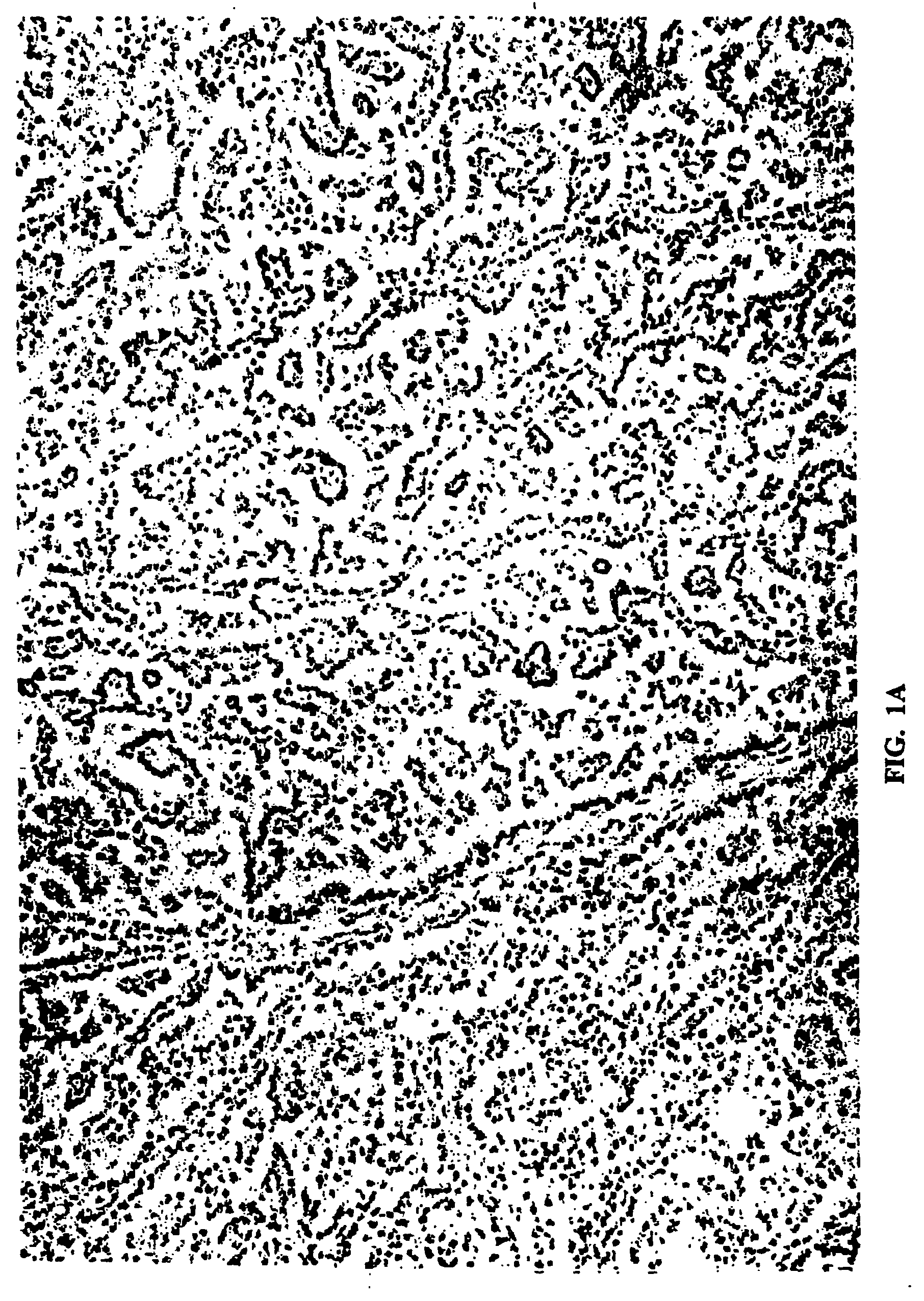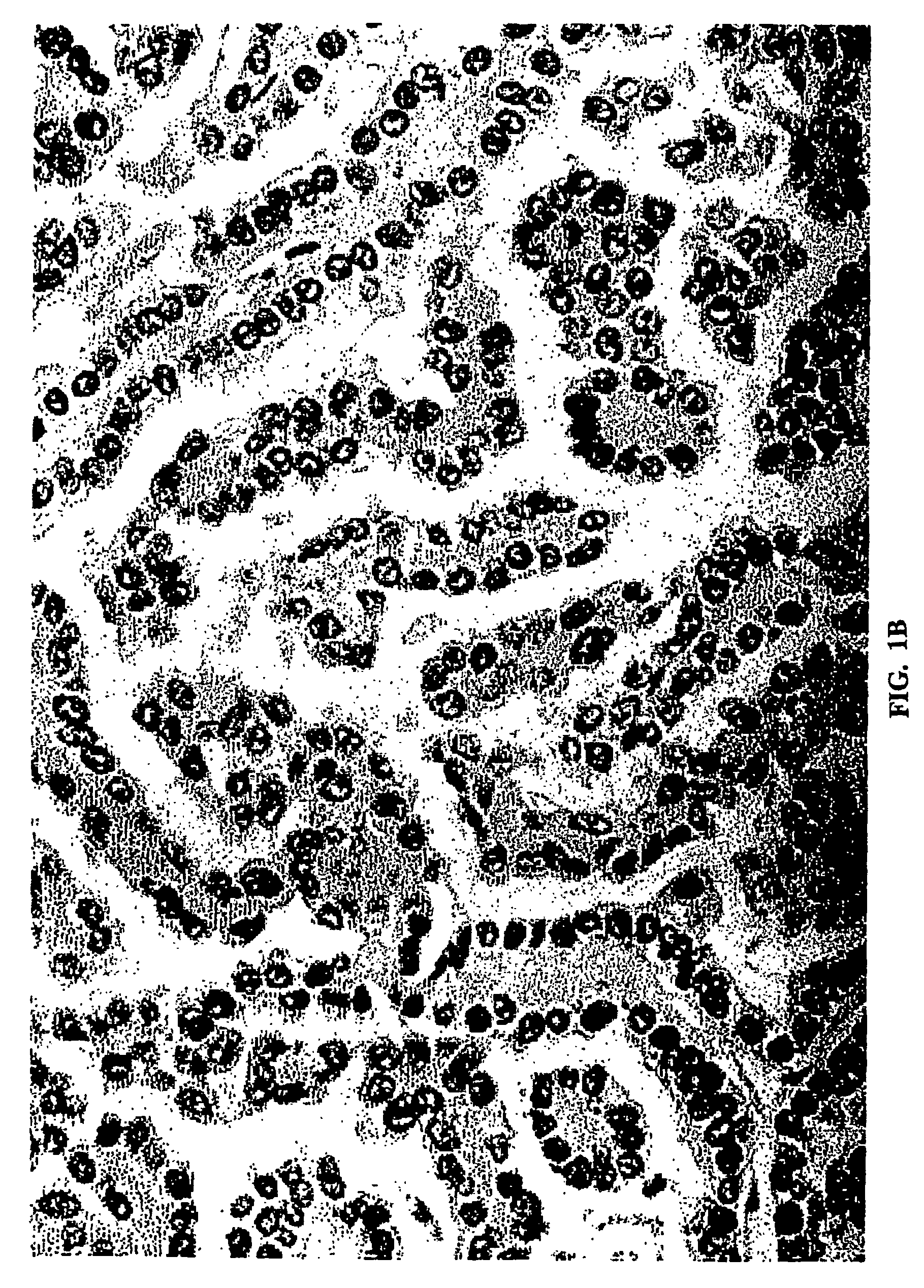Feline bronchioloalveolar lung carcinoma xenograft and cell line
- Summary
- Abstract
- Description
- Claims
- Application Information
AI Technical Summary
Benefits of technology
Problems solved by technology
Method used
Image
Examples
example 1
Materials and Methods For Characterizing BAC
[0093] Total RNA extracted from the BAC cell line was reverse transcribed using an oligo dT primer (Superscript™, Life Technologies) and then PCR amplified using primers for the feline p53, Hras, K-ras, and N-ras genes as follows:
[0094] p53 (1)
AS: 5′-GGCGCCTATGGTTTCCATTTAG-3′(SEQ ID NO: 3)DR: 5′-CATCCAGTGGCTTCTTCTTTTG-3′(SEQ ID NO: 4)
[0095] K-ras (5)
IaS:5′ GACTGAATATAAACTTGTGG 3′(SEQ ID NO: 5)HaAS:5′ CTATAATGGTGAATATCTTC 3′(SEQ ID NO: 6)
H-ras (5) [0096] IaS: 5′-GACGGAATATAAGCTGGT-3′ (SEQ ID NO: 7) [0097] IIaAS: 5′-CCTGTACTGGTGGATGTCC-3′ (SEQ ID NO: 8)
[0098] N-ras (6)
IaS:5′-GACTGAGTACAAACTGGTGG-3′(SEQ ID NO: 9)IIaAS:5′-CTGTAGAGGTTAATATCCGC-3′(SEQ ID NO: 10)
[0099] Conditions of PCR: PCR reactions were performed in 100 microliters containing 1× buffer (20 mM Tris-HCl (H 8.4), 50 mM KCl), 1.5 mM MgC12, 200 micromolar dNTPs, 200 nM primers and 5 Units of Taq polymerase (Boehringer Mannheim). Cycling for the p53 gene was 30 cycles of 9...
example 2
Production of Recombinant JSRV Capsid Proteins
[0108] Standard molecular biology procedures were used as described (Sambrook J, Fritsch E, Maniatis T. Molecular cloning: 2nd ed., NY: Cold Spring Harbor Lab, 1989). Briefly, the insert fragment, containing a part of the JSRV gag gene (bases 953 to 3030 of the nucleotide sequence (York et al., J of Virology 1992; 66: 4930-4939)) was excised from plasmid pBluescript-Js382 using EcoRI and subcloned into plasmids pMS1S (Sherp A et al., J of Immunological Methods 1990; 128: 81-87) and pGEX1λT (Pharmacia). These constructs were expressed in E. coli host strain NM522 as β-galactosidase (βgal-CA, plasmid pMCA) and glutathione-S-transferase (GST-CA, plasmid pGCA) fusion proteins respectively. Confirmation that the gag gene was in the correct reading frame was obtained by sequencing across the vector-insert junction, as well testing clones for production of β-galactosidase and GST fusion proteins of the appropriate size by western blotting (imm...
example 3
Production of Rabbit Polyclonal Antiserum to JSRV-CA
[0109] A specific rabbit antiserum to JSRV-CA was prepared by immunizing rabbits with 500 μg βgal-CA combined with Freund's incomplete adjuvant. After 15 days the rabbit was boosted with 500 μg of GST-CA bound to the glutathione Sepharose beads. A third injection of GST-CA (500 μg) was given after 4 weeks and the rabbit was bled 15 days after the last injection. By western blotting the rabbit antiserum recognized the two recombinant proteins βgal-CA and GST-CA, as well as the native 25 kDa CA in JSRV. There was no reaction with any other protein in sucrose gradient purified JSRV. Further specificity of this serum for JSRV-CA has been verified extensively in the sheep tumour model, using western blotting, blocking ELISA and immunohistochemistry (Palmarini et al., J of General Virology 1995: 76: 2731-2737). To minimize non-specific reactions, the antiserum may be absorbed overnight at 4° C. with a lysate of IPTG-induced NM522-pMS1S ...
PUM
| Property | Measurement | Unit |
|---|---|---|
| Fraction | aaaaa | aaaaa |
| Fraction | aaaaa | aaaaa |
| Fraction | aaaaa | aaaaa |
Abstract
Description
Claims
Application Information
 Login to View More
Login to View More - R&D
- Intellectual Property
- Life Sciences
- Materials
- Tech Scout
- Unparalleled Data Quality
- Higher Quality Content
- 60% Fewer Hallucinations
Browse by: Latest US Patents, China's latest patents, Technical Efficacy Thesaurus, Application Domain, Technology Topic, Popular Technical Reports.
© 2025 PatSnap. All rights reserved.Legal|Privacy policy|Modern Slavery Act Transparency Statement|Sitemap|About US| Contact US: help@patsnap.com



